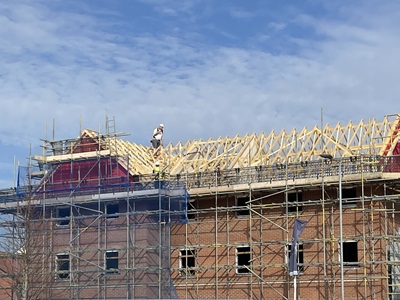Final vote on plan to boost affordable, sustainable and healthy homes
08 Jul 2025

The future of West Suffolk will see increased affordable housing, as well as more sustainable homes built to better support people’s health and wellbeing if a plan is approved next week.
The West Suffolk Local Plan has been five years in the making and has followed a process set by the government. It has been shaped by the 6,400 comments made across three stages of public consultation and undergone independent scrutiny by national planning inspectors in a public hearing.
Now the final stage will see the local plan come before a meeting of West Suffolk Council next Tuesday (15 July) with a recommendation that it be formally adopted.
Subject to that vote, the West Suffolk Local Plan will guide how and where new homes are built, while protecting the countryside and allocating land for employment growth to the year 2041.
But it will also do so much more.
West Suffolk Council would be one of the first local planning authorities in the country to put in place a 40 per cent affordable housing policy for greenfield sites.
It would mean that a developer applying to build 10 or more homes on a greenfield site will have to make 40 per cent of them for affordable housing compared to 30 per cent seen in many other places nationally.
Affordable Housing includes shared ownership as well as affordable rent which is set at 80 per cent of market rents, and social rent which is around 45 per cent of market rents. Both rent schemes are for people on the Home-Link housing register. West Suffolk currently has more than 2,500 households on its register including more than 900 in urgent or high housing need.
New homes will also be more sustainable under the new plan which includes a policy that allows the local planning authority to require developers to consider measures such as solar panels on roofs wherever practically possible. Residents living in them would then have cheaper energy while it would also reduce carbon emissions which impact on climate change.
In a move designed to address living standards, the new local plan brings in a policy to ensure space standards for rooms and gardens in all new houses in West Suffolk as well as balconies for flats.
It also seeks to address the growing need for homes that can be adapted to people’s changing health needs, particularly as people get older. That means that residents will be able to continue to access and enjoy their own home for longer which is better for them, their families and reduces the impact on health and social care.
Other policies include:
- The retention, restoration, enhancement and creation of green infrastructure (GI) is encouraged with all greenfield residential developments of 50 homes or more providing around 40 per cent GI on site to create places that are green and healthy
- The retention of trees, woodland and hedgerows on development sites is strongly encouraged as is the planting of new trees to improve the districts canopy cover
- A first policy for health and wellbeing, recognising that development and how we develop plays a role in the health of communities.
The West Suffolk Local Plan allocates sites for 4,963 new homes alongside 8,712 that already have planning permission. It also sets aside 85 hectares for employment growth ensuring there is land to support the growth of existing West Suffolk businesses keeping jobs in our area as well as encouraging the growth of new businesses and attracting others to relocate. There is also a stronger emphasis to safeguard employment land and community uses across West Suffolk.
Without a local plan, housing growth will still happen. By setting out where it can and can’t take place, the local plan protects the countryside as well as against harmful speculative development such as infilling. The local plan would also bring the council a five-year housing land supply meaning the council would be able to refuse applications for other sites and better protect the democratic voice of communities and councillors to have their say on the planning applications that come in.
And by allocating where homes can be built, the local plan would also insure against piecemeal development and in so doing better secure developer funding to deliver infrastructure needs such as roads, footpaths and cycleways.
Cllr Cliff Waterman, Leader of West Suffolk Council said: “This West Suffolk Local Plan has been five years in the making. It sets out where homes will be built to meet the future needs of our communities and secure land for the growth of new and existing businesses for the benefit of our local economy. Crucially it also protects our countryside. It also delivers much needed affordable housing, alongside measures that will help make homes cheaper to run, with better living standards and that will be accessible and adaptable to people’s changing needs particularly as they get older.
“Thanks are due to Councillor Jim Thorndyke for steering the plan through its final stages, as well as to our excellent and professional officers for all their all the hard work. I’d also like to thank everyone including residents and councillors who have helped shape the local plan over the last five years and I look forward to recommending it to councillors to formally adopt next week.”
Posted in categories: press release, news
